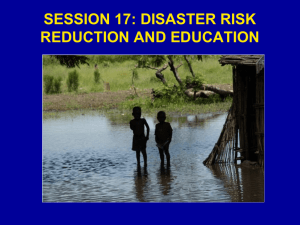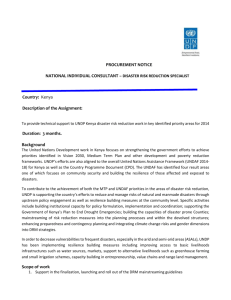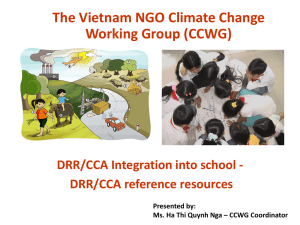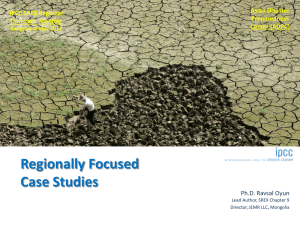Outcome One: Disaster Risk Reduction is integrated into the
advertisement
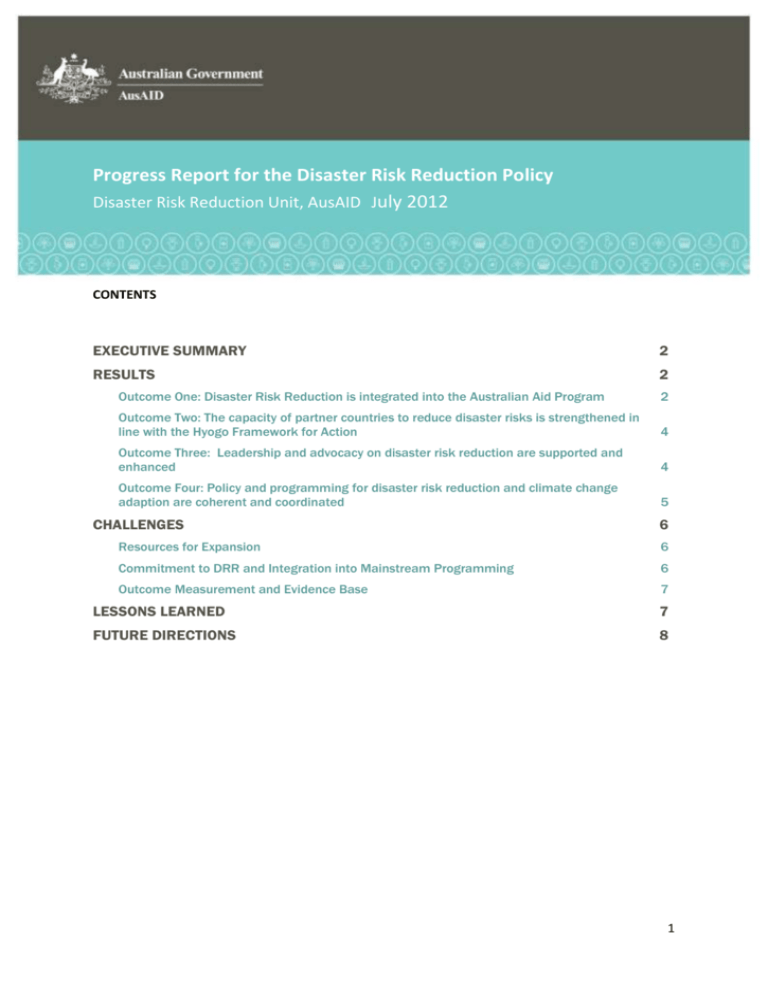
Progress Report for the Disaster Risk Reduction Policy Disaster Risk Reduction Unit, AusAID July 2012 CONTENTS EXECUTIVE SUMMARY 2 RESULTS 2 Outcome One: Disaster Risk Reduction is integrated into the Australian Aid Program 2 Outcome Two: The capacity of partner countries to reduce disaster risks is strengthened in line with the Hyogo Framework for Action 4 Outcome Three: Leadership and advocacy on disaster risk reduction are supported and enhanced 4 Outcome Four: Policy and programming for disaster risk reduction and climate change adaption are coherent and coordinated 5 CHALLENGES 6 Resources for Expansion 6 Commitment to DRR and Integration into Mainstream Programming 6 Outcome Measurement and Evidence Base 7 LESSONS LEARNED 7 FUTURE DIRECTIONS 8 1 EXECUTIVE SUMMARY This Report examines progress made in implementing the 2009 Australian Government disaster risk reduction policy Investing in a Safer Future: a Disaster Risk Reduction policy for the Australian aid program (‘the Policy’). The report has been prepared by the Disaster Risk Reduction (DRR) Unit in the Australian Agency for International Development’s (AusAID) Humanitarian, Preparedness and Response Branch. It builds on the findings of the inaugural Progress Report of October 2010 and discusses results against the four outcomes of the Policy. The findings will guide future planning and investment decisions for DRR in the Australian aid program. The goal of the Policy is ‘reduced vulnerability and enhanced resilience of countries and communities to disasters’. In implementing the Policy, AusAID bilateral programs and the DRR Unit have continued to expand the scale and scope of DRR interventions. Expenditure on DRR rose from $59 million in 2009-10 to over $102 million in 2010-11, representing 2.36% of the total Australian budget for overseas development assistance for that year. (This figure exceeds the target of 1 % of Official Development Assistance spending recommended by the United Nations lnternational Strategy for Disaster Reduction (UNISDR) at the 2009 Global Platform for DRR.) AusAID has also deepened its engagement in policy development with the main international actors in DRR. AusAID was prominent at the 2011 Global Platform for DRR and was co-chair of the World Bank’s Global Facility for Disaster Reduction and Recovery (GFDRR) through 2011. We are one of few countries to be represented on the UNISDR’s advisory panel on post-2015 framework for DRR and we are co-chair of the Friends of DRR group at the UN in New York. But a lot more remains to be done. Since the last DRR Unit Progress Report in 2010, evidence has continued to mount of the increasing severity and frequency of disaster events, and the rapidly increasing exposure to hazards arising from population increase and urbanisation, particularly in the Asia Pacific. In 2011, 302 natural disasters killed more than 29,000 people, affected more than 206 million, and caused record economic loss of US$366 billion. To address this expanding risk, our Policy needs to be implemented in a manner that more evenly reflects the scope of the Hyogo Framework for Action (the international blueprint for DRR). Despite the rapid growth of DRR across the Agency, most activities cluster in emergency preparedness and applied geo-science. We need to better integrate DRR across the whole spectrum of development programming, including climate change adaptation (CCA). And, we need to build a stronger evidence base for DRR programming across AusAID through better and more consistent reporting on impact. RESULTS Achievements since the last Report against each of the four Policy outcomes are summarised below. Outcome One: Disaster Risk Reduction is integrated into the Australian Aid Program The reach of DRR within the Australian aid program rose markedly through 2010-11. Some 64 countries benefited from AusAID-funded DRR activities (up from 32 in 2009-10) and overall expenditure on DRR rose from $59m to over $102m. These activities have tended to focus either on building resilience at community levels through emergency preparedness, or building awareness and capacity through a science-driven, natural hazards approach that generates data risk data and 2 transfers technical know-how. The range of DRR programming included: protecting livelihoods and infrastructure from disasters; strengthening partnerships with scientific agencies; encouraging sound land use planning based on hazard information; improving early warning systems, addressing cyclical food insecurity issues caused by natural hazards (such as droughts and floods); and ensuring that post-disaster reconstruction is based on disaster risk reduction principles, such as ‘build-backbetter’. AusAID made DRR considerations part of post-disaster responses in Pakistan in 2010 (through support for a post disaster needs assessment after the floods) and in Tuvalu in 2011 (through the provision of water tanks and desalination plants in response to its fresh water crisis). A major program in the Philippines was developed in response to a post-disaster needs assessment after cyclone Ketsana. Drawing on the needs assessment the Government of the Philippines and AusAID have developed a package of risk assessments and land use planning guidelines to prepare and protect Metro Manila communities from natural hazards and climate change. Training to increase knowledge on DRR and its integration into the Australian aid program was delivered to a total of around 500 AusAID staff and others, including: Australian Civilian Corps registrars; AusAID supported Red-R deployees; whole-of-government partners and non-government organisation representatives. In April 2012, AusAID staff across South Asia took part in joint DRR, climate change and humanitarian emergency response training which highlighted both integration of DRR and Climate Change Adaption (CCA) and also the links between DRR, humanitarian response, post-disaster recovery and the transition to longer-term development objectives. All these training activities, together with the establishment of Environmental Focal Points, who have a portion of their workload dedicated to DRR and CCA integration, have increased the capacity of staff to integrate DRR and CCA into the aid program. A sign of the increasing profile of DRR in the aid program is the announcement by the Foreign Minister Senator Carr in July 2012 of a $100m initiative over five years to help regional institutions and national governments implement their DRR priorities. 3 Outcome Two: The capacity of partner countries to reduce disaster risks is strengthened in line with the Hyogo Framework for Action The large growth in AusAID funding to DRR has primarily come from bi-lateral programs and demonstrates the increased commitment and capacity of the Agency to engage with in-country counterparts on DRR. In places like Bangladesh, Vietnam and the Pacific we are supporting host governments to build community resilience to natural hazards through awareness, infrastructure and livelihoods programs. AusAID is also funding scientific agencies (Geoscience Australia and the Australian Bureau of Meteorology) to strengthen the capacity of partner countries’ technical agencies to analyse and assess natural hazard risk and potential impact. AusAID funding to the Australia-Indonesia Facility for Disaster Reduction (AIFDR) continued to build the capacity of Indonesian Government to respond to and reduce disaster risks. Working with the Indonesian partners and the World Bank, AIFDR has developed a comprehensive, free and open source software package that produces realistic natural hazard disaster scenarios for better planning, risk reduction and preparedness. In addition, AIFDR has partnered with numerous non-government organisations to reduce the risk of disasters on the ground. For example, AIFDR worked with Nadhatul Ulama, the biggest Islamic organisation in the world, to advocate for the government in East Java to pass laws on disaster management. These laws, now ratified, will lead to the Indonesian government allocating its own budget for sustainable DRR programming in the districts. In the Philippines, partnering with the Australian Bureau of Meteorology has increased the national weather bureau’s forecasting and early warning capacity by 15%. AusAID is supporting local authorities to create multi-hazard maps for 27 high-risk provinces and the development of state-ofthe-art flood, cyclone and earthquake risk and impact analysis for the Greater Metro Manila area. This will inform building codes, land use planning and zoning regulations. In PNG, Geoscience Australia is helping technical agencies to develop new risk assessment information for provinces prone to hazards such as volcanoes, earthquakes and tsunamis. Outcome Three: Leadership and advocacy on disaster risk reduction are supported and enhanced We have continued to build robust relationships with leading DRR institutions. Australia acted as co-chair for the GFDRR through 2011. In this capacity, we helped launch a highly influential research report, ‘Natural Hazards, UnNatural Disasters: The Economics of Effective Prevention’ in New York and Canberra. Australia also provided funding for the translation of this report into five languages to make the information more accessible to partner Governments and communities. Australia co-hosted the 11th GFDRR Consultative Group meeting in Jakarta in November 2011 and we continue to work to strengthen GFDRR governance arrangements, and to enhance its effectiveness as a partner for nations implementing the Hyogo Framework for Action. Australia has also increased its visibility as a supporter of UNISDR, hosting a launch of its 2011 Global Assessment Report on DRR in Canberra and playing a prominent role at the 2011 Global Platform for Disaster Risk Reduction in Geneva by moderating sessions and endorsing the Children’s Charter for DRR. Australia is also represented on the UNISDR Advisory Group which will contribute to the formulation of a new international framework for disaster risk reduction after the Hyogo Framework concludes in 2015. 4 Australia is co-chair of the Friends of DRR Group at the United Nations in New York which brings together donors and developing nations to advocate for recognition of DRR’s importance to the future sustainable development agenda. A strong recognition of DRR was one of the Australian government’s priorities for Rio +20 and in April 2012 the Foreign Minister Senator Carr delivered an address on behalf of 13 members of the Friends of DRR to the UN General Assembly. Senator Carr also announced a new Australian DRR $100 million initiative at the Development Cooperation Forum at the United Nations in July. Other important advocacy work by the DRR Unit included assistance to the International Federation of the Red Cross (IFRC) to develop a Model Act for the Facilitation and Regulation of International Disaster Relief and Initial Recovery Assistance – a concrete tool to help governments prepare for disasters before they strike. The pilot version of the Act was adopted at the 31st Conference of the IFRC in late 2011. Outcome Four: Policy and programming for disaster risk reduction and climate change adaption are coherent and coordinated All DRR training promotes integration between DRR, CCA and Environment. A joint DRR, CCA and Environment intranet website has been established and a joint E-learning package will become mandatory for all AusAID employees in 2012. As an outcome of DRR and climate change training for South Asia in 2012, Bangladesh, Pakistan and Nepal will establish action plans to integrate DRR and CCA into their programming. In practice, however, the majority of AusAID country programs are yet to implement DRR and CCA in a coherent and coordinated manner. The large climate change funding that AusAID is allocating to the Pacific, and the large multi-donor programs which we are entering into elsewhere often have many DRR benefits that are not articulated. Similarly, few DRR programs, even though they also claim to be addressing climate change, specifically link their activities and indicators to CAA outcomes. To an extent this is because the international policy frameworks, governments, regional organizations and donors that undertake DRR and CCA generally work separately from one another. There is some progress though. In the Philippines, AusAID supported the development of national policies and a harmonised CCA/DRR framework and our aid program there will focus particularly on the DRR/CCA interface in education, urban reconstruction and road rehabilitation and maintenance. Vietnam is incorporating DRR into a large multi-donor climate change program (and has identified DRR as an area where Australia may take the lead in policy negotiations). New funding to NGOs through programs such as the community-based climate change action grants, a new Pacific DRR program, the humanitarian partnership agreement and the AusAID NGO Community Program increasingly have integration objectives. 5 CHALLENGES The challenges to the implementation of the Policy which were identified in the last Report in October 2010 remain relevant. This section discusses progress in managing them along with new challenges. Resources for Expansion Progress Made: Since 2010 the DRR Unit has used budget measure funds to build DRR awareness and expand its network across AusAID. It has developed a formal competitive bidding process for these funds in which country programs and thematic areas participate and it undertakes financial tracking and reporting tasks on activities funded from this budget line. A budget measure realignment to take effect in 2012-13 means that approximately $15m will now be available annually to the DRR Unit. The Unit can therefore rely on this funding to build its strategic partnerships with international and regional agencies, as well as manage funding rounds within AusAID. In both cases these funds can be used to test and promote aspects of the Policy such as integration of DRR into infrastructure, education and CCA, that are not yet being taken up as much as they could be across the Agency. The $100m DRR initiative over five years, announced by the Foreign Minister in July 2012, will also be managed by the DRR Unit. The initiative will be implemented in close collaboration with AusAID country programs but it will increase the Unit’s resources substantially. In terms of human resources, a separate Disaster Prevention and Risk Reduction Section was created in mid-2012 which will increase staffing levels in the DRR Unit, including at least 0.5 of a director’s time. Challenges: Despite these increased resources, the DRR Unit does not have access to internationallevel DRR expertise. A pool of DRR technical advisers who can be utilised for short-term tasks should be established by the end of 2012, but these advisers will not be able to provide the level of leadership and representation that is being expected of AusAID at international fora, and will not be in a position to lead on integrating DRR across the Agency. Commitment to DRR and Integration into Mainstream Programming Progress Made: The last DRR Progress Report noted a lack of guidance on how to integrate DRR into mainstream programming and a variable commitment to DRR across AusAID. Since then, many staff have participated in some DRR training and many more country programs are implementing some form of DRR. Challenges: Overall, however, knowledge of DRR, and progress towards DRR integration, continue to be uneven across AusAID. DRR activities tend to cluster in emergency preparedness and geoscience. These are key elements of DRR but while these activities create partnerships with national disaster management and technical agencies, they engage much less with mainstream sectors like planning and financing, infrastructure, livelihoods, food security and education. It is only these agencies that can drive a national integration agenda. 6 Similarly, around 75% of our DRR programming is taking place in the Asia Pacific. Given that this is the world’s most disaster-prone region, prioritising the earthquake, volcano and hydro-related hazards typical of the Asia Pacific is sensible. However, cyclical drought is a hazard to which many of the world’s poorest people are vulnerable. AusAID ’s very substantial food security and humanitarian activities in Africa that work to address community resilience, build sustainable livelihoods and more robust agricultural systems, and respond to climate change, have not always articulated an explicit DRR narrative. The Australian aid policy, An Effective Aid Program for Australia: Making a real difference-delivering real results, encourages country programs to consolidate into fewer, larger programs. The Agency’s current DRR profile shows that it is dispersed across too many countries with too many small, standalone activities. Our DRR programming needs to consolidate by shedding marginal activities and integrating with larger, bilateral ones that are directly contributing to country strategy objectives. However, AusAID sectoral programs are dealing with complex policy and implementation environments and adding DRR into the mix can seem to add even more complexity. To counter this impression, DRR programming must show that it is effective and can help country programs meet their development objectives. Outcome Measurement and Evidence Base Monitoring and evaluation of DRR activities tend to rely on proxies, case studies and anecdote. While the preventative value of DRR makes intuitive sense, it is unlikely that one international norm on the cost to benefit ratio of DRR will be validated. How to determine the number of lives saved, the economic loss averted and the degree of resilience gained through DRR activities, is contentious and hampered by insufficient or unsuitable data. However, building a more empirical evidence base to justify investment in DRR and having simple methodologies available to measure its impact at activity level, is essential for its wider integration into development planning. LESSONS LEARNED The three most important lessons from implementation of the Policy over the last 18 months were: DRR in AusAID is evolving from getting ready to respond to the next disaster event towards building a culture of resilience in our programing. To push this positive evolution forward AusAID needs to build commitment and partnerships in the countries where AusAID works and then ensure that we are positioned to capitalise on opportunities. Leveraging resources and collaborating with other parts of AusAID is also critical for achieving results. Bilateral programs undertook the large majority of DRR programming; the environment team built the Environment Focal Point Network; and the Climate Change Branch took the lead in the E-Learning package. Fostering these cooperative and mutually beneficial relationships is starting to build a constituency for integrated DRR across the Agency. 7 Building awareness of DRR across the Agency remains the key to achieving DRR outcomes. When program areas are trained and supported, they see benefit in including DRR into their programs. This highlights the need to continue to dedicate resources to training and to provide seed funding in support of new DRR initiatives that will point the way to broader and deeper integration of DRR into existing programs. FUTURE DIRECTIONS The main areas of the Policy that remain to be fully implemented are integration of DRR into the aid program, coordinating AusAID DRR and climate change adaptation programming, and measuring results. The better we can do all these things the better we can help partner countries integrate DRR across their development sectors. To move these areas forward the DRR Unit will: fund the Asia Disaster Preparedness Centre to build on its good practice in mainstreaming DRR into sectors like town planning, and UNICEF to finalise norms and standards for integration of DRR into the education sector. In both cases we will be looking for models that can be taken up by countries and AusAID country programs; encourage DRR/CCA integration by making innovative joint programming a criterion within the competitive funding round for country programs that the DRR Unit manages. advocate more strongly for the development of results measurement standards in our dialogue with international partners. Through our membership of UNISDR’s advisory group on a DRR framework post 2015 we will be engaged in discussion of possible targets that can be reported on at global, regional and local levels. We have also agreed to provide regular feedback to GFDRR as it refines its results based management system and reporting over the next year. If resources allow, the Unit will also engage more on vulnerabilities that the international community has been relatively slow to recognise. These include informal settlements in large urban environments (which our Philippines program is addressing) and cyclical drought in environments like the Sahel and the Horn of Africa (as is happening in the Africa program). 8

